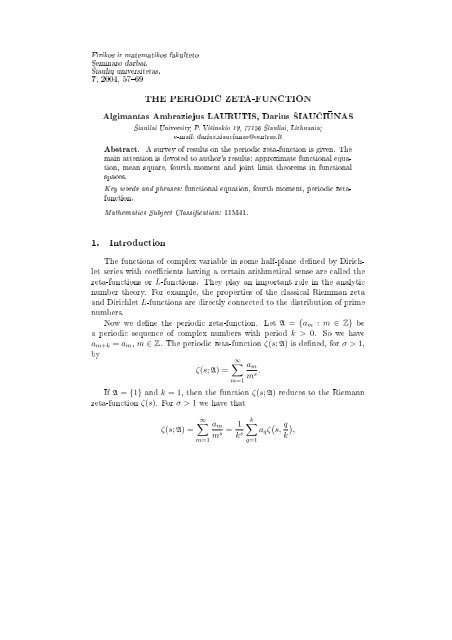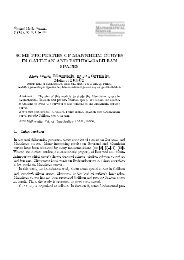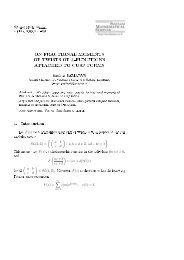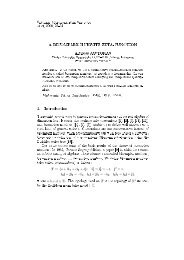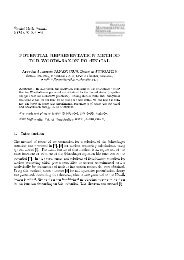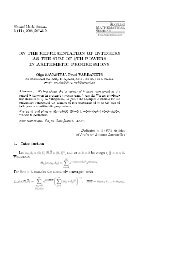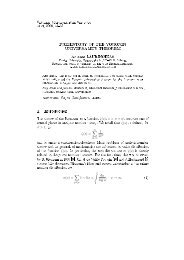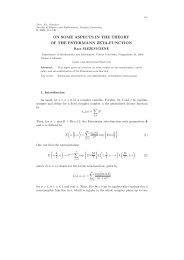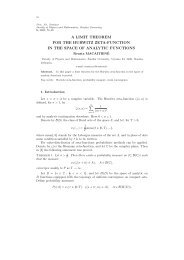THE PERIODIC ZETA-FUNCTION 1. Introduction
THE PERIODIC ZETA-FUNCTION 1. Introduction
THE PERIODIC ZETA-FUNCTION 1. Introduction
Create successful ePaper yourself
Turn your PDF publications into a flip-book with our unique Google optimized e-Paper software.
Fizikos ir matematikos fakulteto<br />
Seminaro darbai,<br />
’iauliu universitetas,<br />
7, 2004, 5769<br />
<strong>THE</strong> <strong>PERIODIC</strong> <strong>ZETA</strong>-<strong>FUNCTION</strong><br />
Algimantas Ambraziejus LAURUTIS, Darius ’IAUƒI UNAS<br />
’iauliai University, P. Vi²inskio 19, 77156 ’iauliai, Lithuania;<br />
e-mail: darius.siauciunas@centras.lt<br />
Abstract. A survey of results on the periodic zeta-function is given. The<br />
main attention is devoted to author's results: approximate functional equation,<br />
mean square, fourth moment and joint limit theorems in functional<br />
spaces.<br />
Key words and phrases: functional equation, fourth moment, periodic zetafunction.<br />
Mathematics Subject Classication: 11M4<strong>1.</strong><br />
<strong>1.</strong> <strong>Introduction</strong><br />
The functions of complex variable in some half-plane dened by Dirichlet<br />
series with coecients having a certain arithmetical sense are called the<br />
zeta-functions or L-functions. They play an important role in the analytic<br />
number theory. For example, the properties of the classical Riemman zeta<br />
and Dirichlet L-functions are directly connected to the distribution of prime<br />
numbers.<br />
Now we dene the periodic zeta-function. Let A = {a m : m ∈ Z} be<br />
a periodic sequence of complex numbers with period k > 0. So we have<br />
a m+k = a m , m ∈ Z. The periodic zeta-function ζ(s; A) is dened, for σ > 1,<br />
by<br />
ζ(s; A) =<br />
∞∑<br />
m=1<br />
a m<br />
m s .<br />
If A = {1} and k = 1, then the function ζ(s; A) reduces to the Riemann<br />
zeta-function ζ(s). For σ > 1 we have that<br />
ζ(s; A) =<br />
∞∑<br />
m=1<br />
a m<br />
m s = 1 k s<br />
k∑<br />
a q ζ ( s, q )<br />
,<br />
k<br />
q=1
58 On the periodic zeta-function series<br />
where ζ(s, α) is the Hurwitz zeta-function<br />
ζ(s, α) =<br />
∞∑<br />
m=0<br />
1<br />
, σ > 1, 0 < α <strong>1.</strong><br />
(m + α) s<br />
Since ζ(s; α) is regular everywhere, except for a simple pole at s = 1 with<br />
residue 1, the last equality gives the analytic continuation of ζ(s; A) to the<br />
whole complex plane except, possibly, a simple pole at s = 1 with residue<br />
a = 1 k<br />
k∑<br />
a m .<br />
m=1<br />
If a m = χ(m), where χ(m) is a Dirichlet character modulo k, then ζ(s; A)<br />
becomes the Dirichlet L-function<br />
L(s, χ) =<br />
∞∑<br />
m=1<br />
χ(m)<br />
m s , σ > <strong>1.</strong><br />
So, the periodic zeta function is a generalization of the classical Riemann<br />
zeta and Dirichlet L-functions.<br />
The function ζ(s; A) was studied by many authors. We will mention some<br />
their results. W. Schnee obtained [14] the functional equation for ζ(s; A). Let<br />
B = {b m : m ∈ Z} with<br />
b m = 1 ∑k−1<br />
a j e −2πij m k ,<br />
k<br />
j=0<br />
and let B ∗ = {b ∗ m, m ∈ Z} with b ∗ m = b −m . Then the function ζ(s; A)<br />
satises the following functional equation [14]<br />
ζ(1 − s; A) = ( k<br />
2π<br />
) sΓ(s) (<br />
e<br />
πi s 2 ζ(s; B) + e<br />
−πi s 2 ζ(s; B ∗ ) ) .<br />
As a special case of the periodic Lerch zeta-function, the function ζ(s; A) also<br />
appears in [2], where its functional equation by another method is derived.<br />
The papers [4] and [12] are devoted to Hamburger-type theorems for<br />
ζ(s; A). We recall that Hamburger's theorem states that any Dirichlet series<br />
which satises the same functional equation as the Riemann zeta-function<br />
ζ(s), and some additional conditions, is a constant multiple of ζ(s). In [4]<br />
it is proved that a special type of functional equations for Dirichlet series<br />
is equivalent to periodicity of the coecients of these series. The theorem
A. A. Laurutis, D. ’iau£i unas 59<br />
of [12] gives a complete characterization of Dirichlet series with periodic<br />
multiplicative coecients which satisfy certain additional conditions.<br />
The paper [3] of T. Funakura is devoted to Kronecker's limit formula for<br />
ζ(s; A). Let<br />
â r = 1 √<br />
k<br />
k∑<br />
a m e −2πim r k<br />
m=1<br />
denote the Fourier transform of a m . Then it is proved that<br />
(<br />
)<br />
â r<br />
lim ζ(s; A) − √<br />
s→1<br />
k(s − 1)<br />
= −√ 1 ∑k−1<br />
k<br />
+ π 2k<br />
m=1<br />
k−1<br />
â r log ( sin πm k<br />
∑<br />
a m ctg πm k<br />
m=1<br />
+ ( â k<br />
√<br />
k<br />
− a k<br />
)<br />
log 2,<br />
)<br />
+<br />
âk √<br />
k<br />
γ 0<br />
where γ 0 is Euler's constant.<br />
The paper [5] is very rich by results on the function ζ(s; A). The statements<br />
of them are complicated, therefore we will mention only some problems.<br />
Let, for σ > 1,<br />
Then it is proved [5] that<br />
F (s, r k ) = ∞ ∑<br />
m=1<br />
e 2πim r q<br />
m s .<br />
ζ(s; A) = √ âk ζ(s) + 1 ∑k−1<br />
√ â r F (s, r<br />
k k k ).<br />
Also, the Laurent expansion at s = 1 for ζ(s; A) is given with explicit form<br />
for the rst three coecients. Similar expressions are obtained also for derivatives<br />
ζ (l) (s; A).<br />
Further, the powers<br />
are considered. Here<br />
ζ l (s; A) =<br />
d l (m) =<br />
∞∑<br />
m=1<br />
∑<br />
d 1 ...d l =m<br />
r=1<br />
d l (m)<br />
m s , σ > 1,<br />
a d1 . . . a dl .
60 On the periodic zeta-function series<br />
Using the properties of ζ(s; A) the Voronoï type formulae for d l (m) are obtained.<br />
J. Steuding in [15] investigated the zeros distribution of ζ(s; A). To state<br />
his results on zeros of ζ(s; A) we need some notations and denitions. Denote<br />
the zeros of ζ(s; A) by ϱ = β + iγ. Moreover, let c A = max{|a m | : 1 m <br />
k}, m A = min {1 m k : a m ≠ 0}, and<br />
A(A) = c A m A<br />
|a m<br />
A | .<br />
Then in [15] it was established that ζ(s; A) ≠ 0 for σ > 1 + A(A).<br />
Dene the numbers â ± m, where â − m coincides with â m , and â + m is obtained<br />
from â − m taking "+" in place "-" in the exponent. Let A ± = {â ± m} and<br />
B(A) = max{A(A ± )}. Then in [15] it was noted that for σ < −B(A) the<br />
function ζ(s; A) can only have zeros close to the negative real axis, if m A<br />
+ =<br />
m A<br />
−, and close to the line<br />
σ = 1 +<br />
πt<br />
log m A −<br />
m A<br />
+<br />
if m A<br />
+ ≠ m A<br />
−. The zeros ϱ of ζ(s; A) with β < −B(A) are called trivial, and<br />
other zeros of ζ(s; A) are nontrivial. So, nontrivial zeros lie in the vertical<br />
strip<br />
−B(A) σ 1 + A(A).<br />
Denote by N(T ; A) the number of nontrivial zeros ϱ of ζ(s; A) with |γ| T<br />
counted with multiplicity. Then in [15] it was proved that<br />
N(T ; A) = T π log kT<br />
√ + B log T.<br />
2πlm A mA −m A<br />
+<br />
Moreover, from the asymptotic formulae for<br />
∑<br />
ϱ nontrivial<br />
|γ|T<br />
( 1)<br />
β −<br />
2<br />
it follows that the most of nontrivial zeros are approximately symmetrically<br />
distributed or lie close to the critical line σ = 1 2. If<br />
lim<br />
T →∞<br />
∑<br />
ϱ nontrivial<br />
|γ|T<br />
( 1) β − ≠ 0,<br />
2
A. A. Laurutis, D. ’iau£i unas 61<br />
then ζ(s; A) has innitely many zeros o the critical line.<br />
Now dene for the nontrivial zeros ϱ = β + iγ of ζ(s; A) the functions<br />
N + (c, T, A) = #{ϱ : β c, |γ| T },<br />
N − (c, T, A) = #{ϱ : β c, |γ| T }.<br />
Then the last result of [15] states that, for δ > 0,<br />
N +( 1<br />
2 + δ, T, A) + N −( 1<br />
2 − δ, T, A) B log log T<br />
= N(T, A).<br />
δ log T<br />
This means that the nontrivial zeros of ζ(s; A) are clustered around the critical<br />
line σ = 2.<br />
1<br />
We else will mention an important result of J. Steuding [16] on the universality<br />
of ζ(s; A). Let meas{A} denote the Lebesgue measure of the set<br />
A ⊂ R, and let, for T > 0,<br />
ν T (. . . ) = 1 meas{τ ∈ [0; T] : . . . },<br />
T<br />
where in place of dots a condition satised by τ is to be written. Suppose<br />
that k is an odd prime, a m is not a multiple of a character modulo k, and<br />
1<br />
a k = 0. Let K be a compact subset of the strip {s ∈ C :<br />
2<br />
< σ < 1} with<br />
connected complement, and let f(s) be a continuous function on K which is<br />
analytic in the interior of K. Then, for any ε > 0,<br />
lim inf<br />
T →∞<br />
ν T<br />
Let, for r 0 and σ 1 2<br />
(<br />
max<br />
s∈K<br />
I r (T, σ) = I r (T, σ; A) =<br />
∣<br />
∣ζ(s + iτ; A) − f(s) ∣ < ε ) > 0.<br />
∫ T<br />
0<br />
∣ ζ(σ + it; A)<br />
∣ ∣<br />
2r dt.<br />
In [7] the quantity I 1 (T, σ) was begun to study using a simple approximation<br />
by a Dirichlet polynomial for ζ(s; A). The length of this polynomial was too<br />
large to obtain a precise asymptotics for I 1 (T, σ). Also, in [7] a limit theorem<br />
for ζ(s; A) in the space of analytic functions was proved, i. e. it was obtained<br />
that the probability measure<br />
ν T<br />
(<br />
ζ(s + iτ; A) ∈ A<br />
)<br />
,<br />
A ∈ B(H( ˆD)),<br />
converges weakly to some probability measure on ( H( ˆD), B(H( ˆD)) ) as T →<br />
∞. Here ˆD = {s ∈ C : 1 2<br />
< σ < 1}, B(S) stands for the class of Borel sets
62 On the periodic zeta-function series<br />
of the space S, and H(G) is the space of analytic on G functions equipped<br />
with the topology of uniform convergence on compacta.<br />
We recall the denition of the weak convergence of probability measures.<br />
Let P n and P be probability measures on ( S, B(S) ) . Then P n converges to<br />
P as n → ∞ if<br />
∫<br />
S<br />
fdP n<br />
∫<br />
−→<br />
n→∞<br />
S<br />
fdP<br />
for any real bounded continuous function f on S.<br />
A more general limit theorem related to the residue a was proved in [8].<br />
2. An approximate functional equation<br />
Now we discuss our results. The rst theorem is devoted to an approximate<br />
functional equation for the function ζ(s; A). In some sense this theorem<br />
has an auxiliary character because an approximate equation is the principal<br />
tool for the investigation of the mean square of ζ(s; A).<br />
Let<br />
and<br />
ψ(a) = cos π( a 2<br />
2 − a − 1 )<br />
8<br />
cos πa<br />
f(α, t) = t log ( 2π ) t +<br />
t 2 − 7π 8 + πα2<br />
2 + πl + πn − παl + 2πy(l − α),<br />
2<br />
and let, as usual, [u] denote the integer part of u.<br />
Theorem 1 ([10]). Let t 1, y = ( t<br />
2π ) 1 2, n = [y], r = [y − q k<br />
Then, for 1 2 σ 1,<br />
ζ(s; A) = k −s k∑<br />
where<br />
q=1<br />
a q<br />
∑<br />
0mr<br />
1<br />
(m + q k )s<br />
+k −s( 2π ) s−<br />
1<br />
k∑<br />
2<br />
e i(t+ π 4 )<br />
t<br />
+k −s( 2π ) σ<br />
2<br />
t<br />
q=1<br />
a q<br />
∑<br />
1mn<br />
e −2πim q k<br />
m 1−s<br />
], l = n − r.<br />
k∑<br />
a q e if( q k ,t) ψ(2y − 2n + l − q k ) + k−s R(s, k),<br />
q=1<br />
R(s, k) = Bt σ 2 −1<br />
k∑<br />
|a q |.<br />
q=1
A. A. Laurutis, D. ’iau£i unas 63<br />
Theorem 1 is derived from an approximate functional equation for the<br />
Hurwitz zeta function ζ(s, α), which gives an approximation for ζ(s, α) in<br />
the critical strip {s ∈ C : 1 2 σ 1}. A similar result for σ = 1 2<br />
only was<br />
also obtained in [13]. As it was observed by A. Balanzario [1], the latter<br />
theorem is a special case of the analogue of the Riemann-Siegel formula for<br />
the Hurwitz zeta-function.<br />
3. The mean square<br />
Now we discuss the asymptotics for the mean square of the function<br />
ζ(s; A) in the critical strip is obtained. For this Theorem 1 is applied. The<br />
cases of a xed σ, 1 2 < σ < 1, of σ = 1 2<br />
and of σ = σ T → 1 2<br />
are considered. Let<br />
+ 0 as T → ∞<br />
K(k) =<br />
k∑<br />
|a q | 2 ,<br />
q=1<br />
and, for 1 2 < σ < 1, C(σ) = max((2σ − 1) −1 , (1 − σ) −1 ).<br />
Moreover, let M q (T ) = [ ( T 2π )1/2 − q k ] .<br />
Theorem 2 ([10]). Let σ, 1 2<br />
< σ < 1, be xed and T → ∞. Then<br />
∫T<br />
( )<br />
I 1 T, σ =<br />
1<br />
= k −2σ T<br />
|ζ(σ + it; A)| 2 dt<br />
k∑ ∑<br />
|a q | 2<br />
q=1<br />
1mM q (T )<br />
1<br />
(m + q k )2σ<br />
+ (2π)2σ−1<br />
2 − 2σ k−2σ K(k)T 2−2σ ∑<br />
− 2πk −2σ<br />
−<br />
k∑ ∑<br />
|a q | 2<br />
q=1<br />
(2π)<br />
2 − 2σ k−2σ K(k)<br />
1mM q(T )<br />
∑<br />
1mM 0 (T )<br />
1mM 0 (T )<br />
1<br />
1<br />
m 2−2σ<br />
(m + q k )2σ−2<br />
1<br />
m 2σ−2<br />
+ Bk 1−2σ K(k)C(σ)T σ log T + Bk 1−σ K(k)C(σ)T 1 2 .
64 On the periodic zeta-function series<br />
Note that all estimates in Theorem 2 are uniform with respect to σ and<br />
k. Theorem 2 improves a similar result of [8]. This is inuenced by the<br />
application of Theorem 1 instead of a simple approximation of ζ(s; A) by a<br />
long nite sum in [8].<br />
Theorem 3 ([17]). Let T → ∞. Then<br />
Here<br />
∫T<br />
( 1) I 1 T, = |ζ( 1 2<br />
2 + it; A)|2 dt<br />
0<br />
= k −1 K(k)T log T<br />
+k −1 K(k)T (2γ 0 − log π − 1) − k −1 T ( K 1 (k) − K 2 (k) )<br />
+Bk 1 2 K(k)T<br />
1<br />
2 log T + BkK(k).<br />
K 1 (k) =<br />
K 2 (k) = k<br />
k∑<br />
q|a q | 2<br />
q=1<br />
k∑<br />
q=1<br />
|a q | 2<br />
q .<br />
∞ ∑<br />
m=1<br />
1<br />
m(mk + q) ,<br />
Note that in [8] the remainder term in a similar theorem has the form<br />
BK(k)T.<br />
Now we consider the mean square of ζ(s; A) near the critical line. Let<br />
σ T = 1 2 + 1<br />
l T<br />
, where l T > 0 and l T → ∞ as T → ∞. Three cases of l T are<br />
l<br />
considered: l T = o(log T), log T = o(l T ) as T → ∞ and lim T<br />
T →∞<br />
log T = κ ≠ 0.<br />
The results are stated in the following theorems.<br />
Theorem 4 ([11]). Let l T = o(log T ) as T → ∞. Then<br />
I 1 (T, σ T ) = k −2σ T<br />
K(k)T l T + T<br />
+Bk 1−2σ T<br />
K(k)T l T exp<br />
k∑ |a q | 2<br />
q 2σ T<br />
q=1<br />
+Bk 1−σ T<br />
K(k)T 1 2 log T.<br />
Theorem 5 ([11]). Let log T = o(l T ) as T → ∞. Then<br />
I 1 (T, σ T ) = k −2σ T<br />
K(k)T log T + T<br />
{<br />
− log T }<br />
+ Bk −2σ T<br />
K(k)T<br />
l T<br />
k∑<br />
q=1<br />
|a q | 2<br />
q 2σ T<br />
+ Bk1−2σ T<br />
K(k)T
A. A. Laurutis, D. ’iau£i unas 65<br />
Theorem 6 ([11]). Let lim<br />
T →∞<br />
+Bk −2σ T<br />
K(k) T log2 T<br />
l T<br />
+ Bk 1−σ T<br />
K(k)T 1 2 log T.<br />
l T<br />
log T<br />
= κ ≠ 0. Then, as T → ∞,<br />
I 1 (T, σ T ) = k −2σ T<br />
K(k) κ ( )<br />
k∑<br />
1 − e<br />
− 2 |a q | 2<br />
κ T log T + T<br />
2 q 2σ T<br />
q=1<br />
+o(k −2σ T<br />
K(k)T log T ) + Bk 1−2σ T<br />
K(k)T<br />
+Bk 1−σ T<br />
K(k)T 1 2 log T.<br />
In Theorems 46 all estimates again are uniform with respect to k.<br />
4. The fourth moment<br />
The investigations of the fourth power moment is a very dicult problem<br />
even for the Riemann zeta-function and Dirichlet L-functions. Therefore, we<br />
obtain only estimate for I 2 (T, 1 2<br />
), moreover, we consider a simple case of<br />
prime k. In this case the function ζ(s; A) can be written in the form<br />
ζ(s; A) = 1 ∑k−1<br />
ϕ(k)<br />
∑<br />
q=1 χ( mod k)<br />
χ(q)a q L(s, χ) + a k<br />
ζ(s). (1)<br />
ks Here ϕ(k) denotes the Euler function. From this, using the well-known<br />
approximate functional equations for L(s, χ), L(s, χ 1 )L(s, χ 2 ) and for ζ(s),<br />
ζ 2 (s), an approximate functional equation for ζ 2 (s; A) can be obtained. However,<br />
the later functional equation is too complicated to use it for the investigation<br />
of the asymptotics for I 2 (T, σ). Therefore, we use directly (1) and<br />
known estimates for the fourth power moment of L(s, χ) and ζ(s) to obtain<br />
the following result.<br />
Theorem 7 ([18]). Let k be a prime number, and T → ∞. Then<br />
I 2 (T, 1 2 ) = Bk3 K 2 (k)T log 4 T.<br />
The estimate of Theorem 7 with respect to T has a precise order, because<br />
the same estimate is valid in the case a m = χ(m).
66 On the periodic zeta-function series<br />
5. Joint limit theorem<br />
Now we discuss the functional limit theorems for periodic zeta-function.<br />
Let D = {s ∈ C : σ > 1 2<br />
}, and let H(D) and M(D) denote the spaces of<br />
analytic and meromorphic on D functions, respectively, equipped with the<br />
topology of uniform convergence on compacta. Let γ be the unit circle on<br />
C, and let<br />
Ω = ∏ p<br />
where γ p = γ for each prime p. The innite-dimensional torus Ω is a compact<br />
topological Abelian group, therefore on (Ω, B(Ω)) the probability Haar<br />
measure m H exists. Thus we obtain a probability space (Ω, B(Ω), m H ). Denote<br />
by ω(p) the projection of ω ∈ Ω to the coordinate space γ p , and let, for<br />
m ∈ N,<br />
ω(m) = ∏<br />
p α ‖m<br />
γ p ,<br />
ω α (p),<br />
where p α ‖m means that p α | m but p α+1 ∤ m.<br />
Let<br />
ˆζ(s; A) = (1 − 2 1−s )ζ(s; A).<br />
Theorem 8 ([9]). The probability measure<br />
ν T (ˆζ(s + iτ; A) ∈ A),<br />
A ∈ B(H(D)),<br />
weakly converges to the distribution of the H(D)-valued random element<br />
(<br />
1 − 2ω(2)<br />
2 s ) ∞<br />
∑<br />
m=1<br />
a m ω(m)<br />
m s<br />
as T → ∞.<br />
Theorem 8 is used to obtain joint limit theorems for periodic zeta-functions.<br />
Let A j = {a jm : m ∈ Z}, j = 1, . . . , n, be a sequence of complex<br />
numbers with periods k j > 0. Dene, for σ > 1,<br />
Let<br />
ζ(s; A j ) =<br />
∞∑<br />
m=1<br />
a(j) = 1 k j<br />
a jm<br />
, j = 1, . . . , n.<br />
ms k j<br />
∑<br />
m=1<br />
a jm .
We also use the notation<br />
A. A. Laurutis, D. ’iau£i unas 67<br />
H r (D) = H(D) × · · · × H(D) ,<br />
} {{ }<br />
M r (D) = M(D) × · · · × M(D) .<br />
} {{ }<br />
r<br />
We suppose that a(1) = · · · = a(r) = 0 and a(r + 1), . . . , a(k) ≠ 0, where<br />
r = 0, 1, . . . , n. On the probability space (Ω, B(Ω), m H ), dene the H n (D)-<br />
value random element F (s, ω; A 1 , . . . , A n ) by the formula<br />
where<br />
F (s, ω; A 1 , . . . , A n ) = (ζ(s, ω; A 1 ), . . . , ζ(s, ω; A n )),<br />
ζ(s, ω; A j ) =<br />
∞∑<br />
m=1<br />
r<br />
a jm ω(m)<br />
m s , ω ∈ Ω, j = 1, . . . , n.<br />
Denote H r M n−r = H r (D) × M n−r (D). Our main result is contained in the<br />
following theorem.<br />
Theorem 9 ([9]). The probability measure<br />
ν T ((ζ(s + iτ; A 1 ), . . . , ζ(s + iτ; A n )) ∈ A), A ∈ B(H r M n−r ),<br />
weakly converges to the distribution of the random element F (s, ω; A 1 , . . . , A n )<br />
as T → ∞.<br />
Theorem 9 is derived from the following multidimensional result. Let<br />
and<br />
ˆζ(s, ω; A j ) =<br />
Moreover, we put<br />
p(s) = 1 − 2 2 s ,<br />
(<br />
1 − 2ω(2)<br />
2 s ) ∞<br />
∑<br />
2ω(2)<br />
p(s, ω) = 1 −<br />
2 s ,<br />
m=1<br />
a m ω(m)<br />
m s , j = 1, . . . , n.<br />
H r,2(n−r) = H r (D) × H 2(n−r) (D),<br />
and dene a probability measure<br />
P T (A) = ν T ((ζ(s + iτ; A 1 ), . . . , ζ(s + iτ; A r ), p(s + iτ),<br />
ˆζ(s + iτ; A r+1 ), . . . , p(s + iτ)ˆζ(s + iτ; A n )) ∈ A),<br />
A ∈ B(H r,2(n−r) ).<br />
Theorem 10 ([9]). The probability measure P T converges weakly to the distribution<br />
of the random element<br />
(ζ(s, ω; A 1 ), . . . , ζ(s, ω; A r ), p(s, ω), ˆζ(s, ω; A r+1 ), . . . , p(s, ω), ˆζ(s, ω; A n )).<br />
as T → ∞.
68 On the periodic zeta-function series<br />
References<br />
[1] A. A. Balanzario, A Riemann-Siegel formula for the Hurwitz zeta-function,<br />
Boletin Soc. Matem. Mexicana (3), 10, 113 (2004).<br />
[2] B. C. Berndt and L. Schoenfeld, Periodic analogues of Euler-Maclaurin and<br />
Poisson summation with applications to number theory, Acta Arith., 28, 23<br />
68 (1975).<br />
[3] T. Funakura, On Kronecker's limit formula for Dirichlet series with periodic<br />
coecients, Acta Arith., 55, 5973 (1990).<br />
[4] P. Gérardin, W. L. Wen-Ching, Functional equations and periodic sequences,<br />
in: Théorie des Nombres, C. R. Conf. Int., Quebéc /Canada, 1987, 267279<br />
(1989).<br />
[5] M. Ishibashi, S. Kanemitsu, Dirichlet series with periodic coecients, Result.<br />
Math., 35, 7088 (1999).<br />
[6] A. Ivi£, The Riemann zeta-function, New York, John Wiley & Sons (1985).<br />
[7] A. Ka£enas, A. Laurin£ikas, A note on the value distribution of the periodic<br />
zeta-function, Liet. Mat. Rink., 40 (spec. issue), 2832 (2000).<br />
[8] A. Ka£enas, A. Laurin£ikas, On the periodic zeta-function, Lith. Math. J.,<br />
41(2), 168177 (2001).<br />
[9] A. Ka£enas, D. ’iau£i unas, On the periodic zeta-function. III, in: in: Analytic<br />
and Probab. Methods in Number Theory. Proc. 3rd Palanga Conf., A. Dubickas<br />
et al. (Eds.), Vilnius, TEV, 99108 (2002).<br />
[10] A. Laurin£ikas, D. ’iau£i unas, On the periodic zeta-function. II, Liet. Mat.<br />
Rink., 41(4), 461476 (2001) (in Russian) = Lith. Math. J., 41(4), 361372<br />
(2001).<br />
[11] A. Laurin£ikas, D. ’iau£i unas, The mean square of the periodic zeta-function<br />
near the critical line, Chebyshevsky sbornik, 4(3), 144155 (2003).<br />
[12] I. I. Piatetski-Shapiro, R. Raghunathan, On Hamburger's theorem, Amer.<br />
Math. Soc. Transl. Ser. 2, 169, 102120 (1995).<br />
[13] V. V. Rane, On the mean square of Dirichlet L-series, J. London Math. Soc.<br />
(2), 21, 203215 (1980).<br />
[14] W. Schnee, Die Funktionalgleichung der Zetafunktion und der Dirichletschen<br />
Reiben mit periodishen Koezienten, Math. Z., 31, 378390 (1930).
A. A. Laurutis, D. ’iau£i unas 69<br />
[15] J. Steuding, On Dirichlet series with periodic coecients, Ramanujan J., 6,<br />
295306 (2002).<br />
[16] J. Steuding, Value-distribution of L-functions and allied zeta-functions with<br />
an emphasis on aspects of universality, Habilitationschrift, J. W. Goethe-<br />
Universitat, Frankfurt (2003).<br />
[17] D. ’iau£i unas, On the mean square of the periodic zeta-function on the critical<br />
line, Liet. Mat. Rink., 41 (spec. issue), 128133 (2001).<br />
[18] D. ’iau£i unas, A. A. Laurutis, On the fourth moment of the periodic zetafunction,<br />
Liet. Mat. Rink., 44 (spec. issue) (2004), (to appear).<br />
Periodine dzeta funkcija<br />
A. A. Laurutis, D. ’iau£i unas<br />
Straipsnyje pateikta periodines dzeta funkcijos rezutatu apºvalga. Ypatingas<br />
demesys skiriamas rezultatams, gautiems autoriaus: artutinei funkcinei lyg£iai,<br />
vidurkiui, ketvirtajam momentui bei daugiamatems ribinems teoremoms funkcinese<br />
erdvese.<br />
Rankra²tis gautas<br />
2004 10 20


